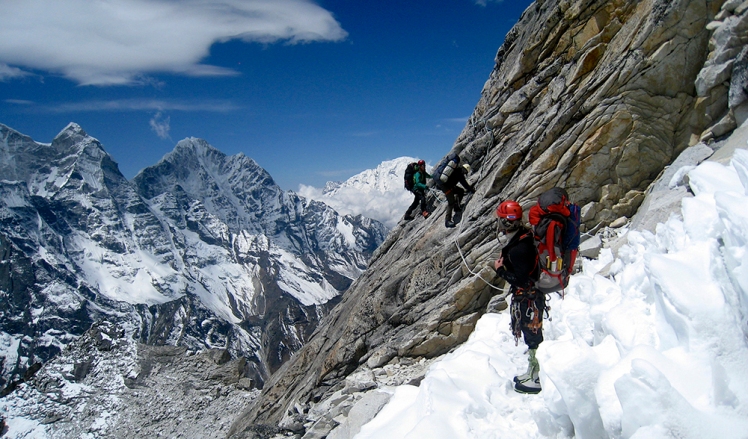The stunning pyramid of Ama Dablam “Mother’s necklace” is regarded as one of the world’s most exquisite and sought after peaks, alongside the infamous Matterhorn and Khan Tengri.
But with all its beauty and charm, it attracts limited climbers. One of the reasons sighted for this is the increasing number of fatalities, mostly been down to human error and judgment.
The ambitious and experienced mountaineer will find the 6,812 meters (22,349 ft) South West Ridge an acceptable challenge.
One has to take the standard route up Ama Dablam which offers steep snow, ice and rock climbing in exhilarating and exposed situations. Fixed lines are used in the ascent, to aid speed and efficient movement on this impressive mountain.
Climbers who are planning to ace Ama Dablam need to be careful. The peak is not a cake walk. It calls for a more thorough approach and preparation.
We summarise 10 things one needs to consider for climbing Ama Dablam.
#1. Ama Dablam is a technical mountain but, with the use of fixed ropes, it is within the realm of mere mortals.
But you need the skills and level of understanding about using the climbing gear to have any realistic chance.
To begin with, start rock climbing indoors and outdoors under an instructor in a single pitch terrain. Learn how to fit and adjust a rock climbing harness, helmet. Learn how to tie into the end of the rope with a rethreaded figure of 8 knot and a stopper knot. Learn the functioning of ‘snap gate,’ ‘locking’ and ‘twist lock’ karabiners. Learn how to use a belay plate to safeguard the leader and how to hold a small slip or fall. Understand the concept of belay plate orientation. Learn how to tie and adjust a clove hitch. Learn how to uncoil and prepare the rope for a climbing session. Learn how to coil a rope at the end of the session
Progress on to multi pitch outdoor climbs as a second and, in due course, as a leader. Aim to be seconding up to HVS so that you are comfortable on steep terrain and have a great understanding about rope and stance management, the limitations of sometimes being on small ledges and belays, how to adapt to changing weather conditions and the importance of eating and drinking whilst on the route.
Learn to abseil with an independent releasable safety rope managed by an instructor or leader.
Learn how to use crampons and ice-axe on snowy terrain.
#2. Run the expedition as a tight ship with a firm grasp on logistics and manpower.
You need a proficient Base Camp crew and experienced, competent and trustworthy Climbing Sherpas. The leader should understand acclimatization and has a grasp of Wilderness First Aid. He should get along with the local staff and communicate effectively.
#3. The expedition needs the safety net of trustworthy agents who can organize helicopter rescue and who can then deal with an evacuation.

#4. Establish an Advance Base Camp at around 5,400 meters.
This helps climbers from the rigors of a 1,400-meter ascent from Base Camp to Camp 1. There is a spring just above Advance Base Camp that serves the water purpose. Sometimes it completely freezes. In that case, ferrying water supplies from Base Camp is advisable.
#5. Camp 2 does not have the space to establish larger groups.
If the team is not well acclimatized, better to camp the night at a lower altitude.
#6. Ama Dablam climb is a lot more difficult than what it looks.
Expect a lot of scrambling, few Diff to Sev pitches, a bit of VS & HVS climbing, some grade 3 terrain and lots of Alpine style ground. Be prepared to be able to deal with an ever changing mountain environment for multiple days. Even if you are not the one leading the HVS, the steepness of the climb can be overwhelming.
#7. The ropes need to be tested before committing to them and, where possible, other ropes should be clipped as a backup.
A few fatalities occurred on Ama Dablam when the climbers chose to be complacent and use the ropes fixed by previous climbing parties without testing them.
#8. Commit to a safe, methodical system for dealing with re-belays as you abseil down.
A few accidents occurred on this route when the climbers did not properly tie the rope off at the bottom to the next re-belay while abseiling. These are all avoidable mishaps.
#9. Ama Dablam is much colder than one may think.
One should not compare this to a trekkable peak like Island Peak. The alpine style campsites are exposed to bad weather and strong winds. Carry decent quality clothing and gear. Have good quality spare mitts and use them before your hands get cold. Always use foot and hand warm up pads on summit day. Use a good quality snug boots to avoid cold feet. Remembering the best way to not get cold hands is to not let them get cold in the first place.
10. Never underestimate the mountain and overestimate your own ability.
Chances are you may not summit the mountain due to conditions not in your control.
Having said that, one can avoid the case of a lack of personal preparation and attention to detail. With better training and planning before the expedition, a successful summit is within your grasp.
Image credit: Himalayan Ascent | Special thanks to Tim Mosedale for technical inputs.

I would love to climb this peak some day!
LikeLike
My lifegoal is to climb this mountain one day alone. with all knowledge, cost that come along organising and experience which I do not have to much now. i’m gonna dream a few more years until it is going to be reality one day.
LikeLike
All the best in your endeavours Willem
LikeLike